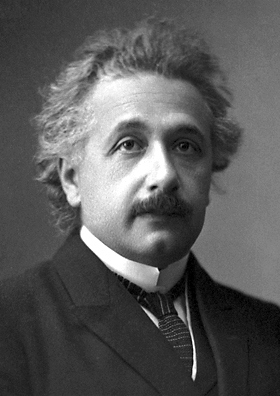 Albert Einstein never cared too much about receiving awards and honors (or even birthdays, since Pi Day is this week), and that included the Nobel Prizes, which were established in 1901, at roughly the same time as Einstein was beginning his research career in physics. When he finally won the 1921 Prize (awarded in 1922), he did not win for his most famous achievement, Relativity Theory, which was still deemed too speculative and uncertain to endorse with the Prize. Instead, he won for his 1905 proposal of the law of the photoelectric effect and for general "services to theoretical physics." It was a political decision by the Nobel committee; Einstein was so renowned that their failure to select him had become an embarrassment. However, the only part of his brilliant portfolio that they either understood or trusted sufficiently to name for the award was this relatively minor implication of his 1905 paper on particles of light. The final irony in this selection was that, among the many controversial theories that Einstein had proposed in the previous 17 years, the only one not accepted by almost all of the leading theoretical physicists of the time was precisely his theory of light quanta (or photons), which he had used to find the law of the photoelectric effect!
Albert Einstein never cared too much about receiving awards and honors (or even birthdays, since Pi Day is this week), and that included the Nobel Prizes, which were established in 1901, at roughly the same time as Einstein was beginning his research career in physics. When he finally won the 1921 Prize (awarded in 1922), he did not win for his most famous achievement, Relativity Theory, which was still deemed too speculative and uncertain to endorse with the Prize. Instead, he won for his 1905 proposal of the law of the photoelectric effect and for general "services to theoretical physics." It was a political decision by the Nobel committee; Einstein was so renowned that their failure to select him had become an embarrassment. However, the only part of his brilliant portfolio that they either understood or trusted sufficiently to name for the award was this relatively minor implication of his 1905 paper on particles of light. The final irony in this selection was that, among the many controversial theories that Einstein had proposed in the previous 17 years, the only one not accepted by almost all of the leading theoretical physicists of the time was precisely his theory of light quanta (or photons), which he had used to find the law of the photoelectric effect!
In keeping with his relative indifference to such honors, Einstein declined to attend the award ceremony because he had previously committed to a lengthy trip to Japan at that time. Such was his indifference that when news reached him during his long voyage to Japan, he neglected to even mention it in his travel diary.
While Einstein himself barely dwelt at all on this honor, it is an interesting exercise to ask how many Nobel-caliber breakthroughs Einstein made during his productive research career. This analysis has a bit in common with fantasy sports, in which athletes are judged and ranked by their statistical achievements, and arguments are made about who was the GOAT ("greatest of all time"). Let's call it fantasy physics. Join the fun as we count down Einstein's Nobel prize-winning efforts:
- Let's start with the Prize he did receive. It absolutely was deserved, if the committee had had the courage to write the citation, "for his proposal of the existence of light quanta." The photon concept was unambiguously confirmed in experiments by 1925, and now is considered the paradigm for our modern quantum theory of force-carrying particles. So the photon is a Nobel slam dunk.
Here we exhaust what most working physicists would immediately recognize as Einstein's works of genius, and we're only at 2.5 Nobels. But it is a remarkable fact that Einstein's work on early atomic theory -- what we now call quantum theory -- is vastly underrated. This is partially because Einstein himself downplayed it. He famously rejected the final version of the theory, dismissing it with the famous phrase, "God does not play dice." But if one looks at what he actually did, the Nobels keep piling up:
- Most textbooks credit German physicist, Max Planck, with introducing the radical notion of quantization of energy -- the idea that when energy is exchanged between atoms and radiation (e.g. light), it can only happen in discrete chunks. However, Planck didn't really say this in his work; he said something much more provisional and ambiguous. It was Einstein in his 1905 paper (but then much more clearly in a follow-up paper on the vibrations of atoms in 1907) who really stated the modern principle first. He then boldly applied it to the mechanical motion of atoms in solids, even when they are not exchanging energy with radiation. Despite the textbooks, Einstein clearly should have shared Planck's Nobel Prize for the principle of quantization of energy. We are up to 3.0 Nobels for Big Al.
So we are at 5.0 "units" of Nobel Prize but seven trips to Stockholm. And this leaves out other arguably Nobel-caliber achievements (Brownian motion as well as the Einstein-Podolsky-Rosen effect, which underlies modern quantum information physics). And wait a minute -- when someone shares the Nobel Prize do we refer to them as a "half- Laureate"? No way. Even scientists who get a "measly" third of a Prize are Nobel Laureates for life. Thus by the standard we apply to normal humans, Einstein deserved at least seven Nobel Prizes. So next time you make your fantasy scientist draft, you know who to take at number one.
This article is cross-posted from a longer piece at the Princeton University Press web site.
A. Douglas Stone is author of Einstein and the Quantum: The Quest of The Valiant Swabian.